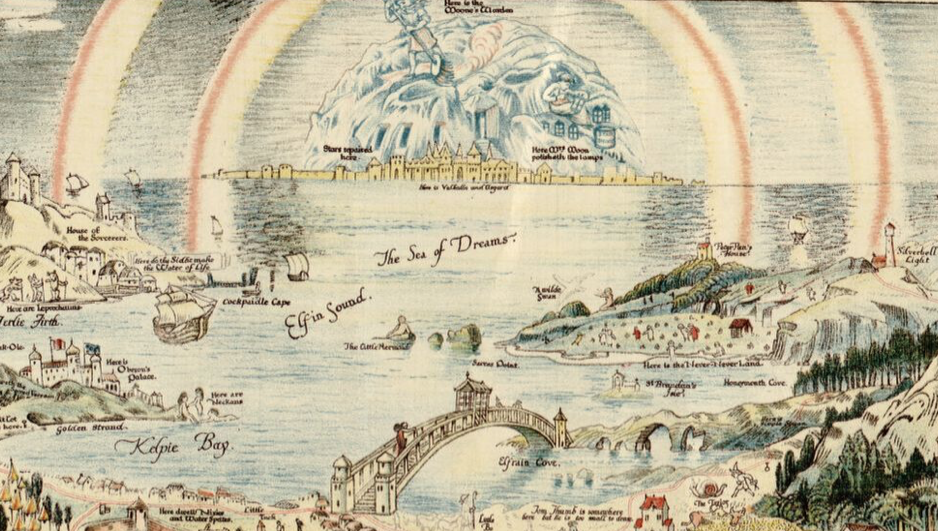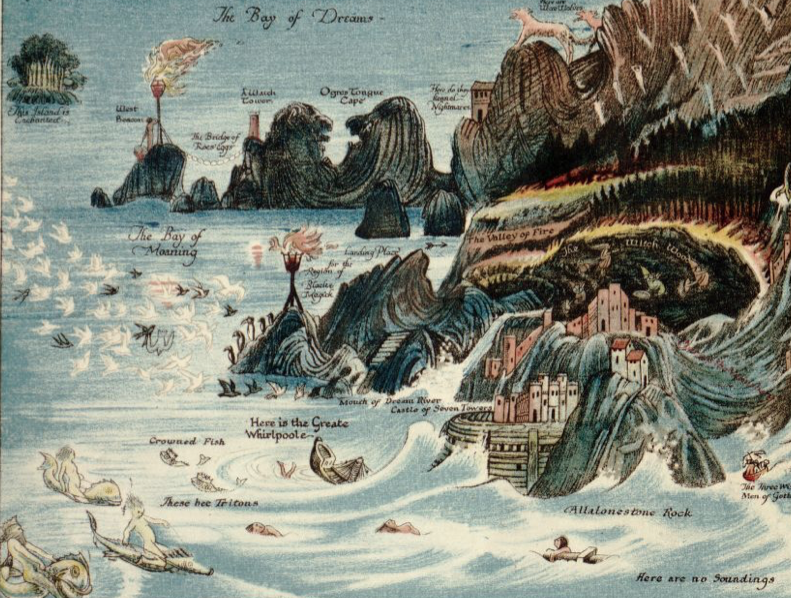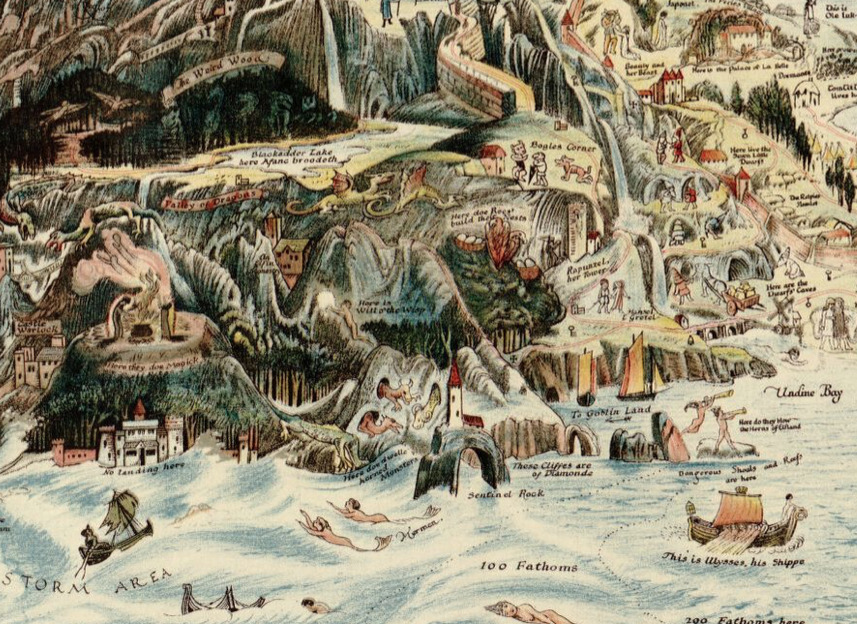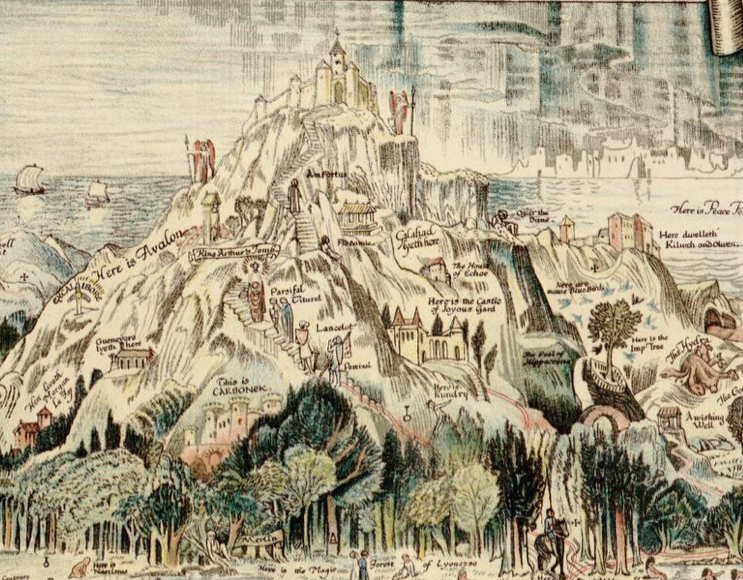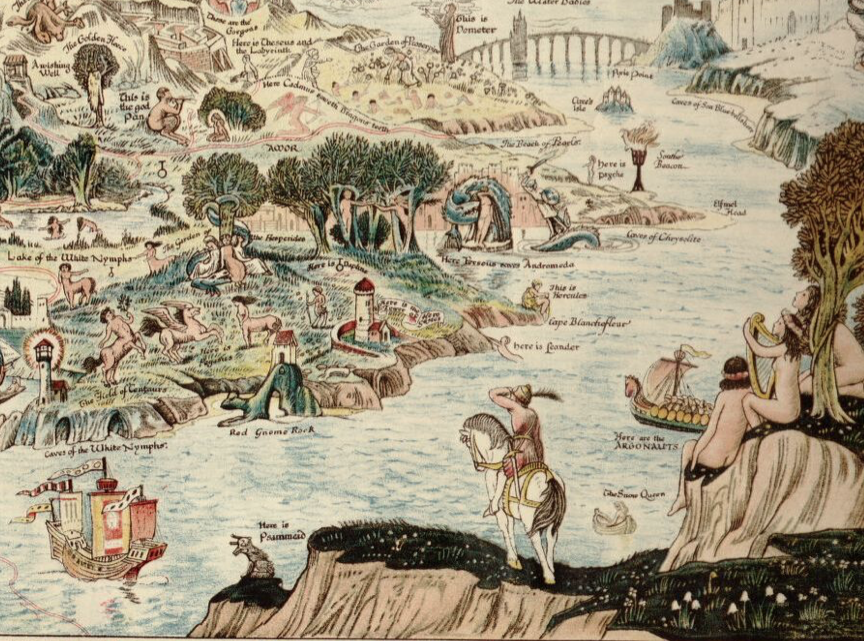[Most Recent Entries] [Calendar View]
Wednesday, March 20th, 2019
| Time | Event |
| 2:00p | Behold the Anciente Mappe of Fairyland, a Fantastical 1917 Mashup of Tales from Homer’s Odyssey, King Arthur, the Brothers Grimm & More
For most of publishing history, books for children meant primers and preachy religious texts, not mythical worlds invented just for kids. It’s true that fairy tales may have been specifically targeted to the young, but they were never childish. (See the original Grimms' tales.) By the 19th century, however, the situation had dramatically changed. And by the turn of the century, childlike fairy stories and fantasies enjoyed wide popularity among grown-ups and children alike, just as they do today. Witness the tremendous success of Peter Pan. The character first appeared as a seven-day-old baby in a satirical 1902 fantasy novel by Scottish writer J.M. Barrie. The novel became a play. Pan was so beloved that Barrie’s publisher excerpted his chapters and published them as Peter Pan in Kensington Gardens. Then followed Barrie’s 1904 play, Peter Pan, or The Boy Who Wouldn’t Grow Up, in which baby Pan had grown up at least just a little. Only after this history of Pan entertainments did Barrie write Peter and Wendy, the story we learned as children through Disney adaptations or the 1911 original.
Pan’s influence is wide and deep, and over a century long. In 1917, one of the early adopters of Barrie’s Neverland fantasy concept expanded on its world with a version called “Fairyland,” described in an illustrated map of such a place. The artist, Bernard Sleigh, “begins with a stormy sea,” writes Jessica Leigh Hester at Atlas Obscura. (That is, if we read the map from left to right.) “There, waves lash the shore and tritons ride piscine steeds, while a wooden ship and an unfortunate soul are half-sunk nearby, in a white whirlpool.” The influence of J.M. Barrie’s descriptions is readily apparent. The Anciente Mappe of Fairyland (see the map in full here) “mashes up dozens of stories to make a comprehensive geography of make-believe,” writes Slate’s Rebecca Onion: “Rapunzel’s tower, cheek by jowl with Belle’s palace from ‘Beauty and the Beast’; Humpty Dumpty on a roof, overlooking Red Riding Hood’s house; Ulysses’ ship, sailing past Goblin Land.” It’s a “Where’s Waldo of Fantasy Easter Eggs,” by an English landscape painter “who wrote extensively about fairies in England.” Sleigh was not only a fantasist, he was also a true believer.
Like Arthur Conan Doyle, Sleigh promoted the existence of fairies, and wrote an earnest work of fiction called The Gates of Horn: Being Sundry Records from the Proceedings of the Society for the Investigation of Fairy Fact and Fallacy in 1926. Like Doyle, he was a talented and popular artist looking for magic in a world of machinery. “The ancient map of Fairyland,” with its visual anthology of literature, folk tale, and mythology, “is said to have been his most famous work,” writes the David Rumsey Map Collection. It was designed “during the ‘Arts & Crafts’ movement, which was in reaction to the Industrial revolution.” Like J.R.R. Tolkien, another artist who found inspiration in Barrie’s fantasy world, Sleigh worked against a backdrop of world war. Onion quotes historians Tim Bryars and Tom Harper’s comment that “compared with the devastated, bomb-blasted landscape of northern France, this vision of a make-believe land may have seemed a seductive escape for a European society bearing the psychological and physical scars of mass conflict.”
Unlike Tolkien, however, or contemporary inheritors of the Peter Pan tradition like J.K. Rowling a century later, or the earlier Romantic lovers of mythology and folk tale, Sleigh’s map invites a light reprieve from the horrors of war. “Any small amount of violence or trauma you might find in ‘Fairyland’ could easily be evaded,” writes Onion, “by moving on to the next area of the map, where a new set of stories unfolds.” Download high resolution scans of An Anciente Mappe of Fairyland: newly discovered and set forth from the Library of Congress and the David Rumsey Map Collection, where you can also purchase a print. (The map physically resides at the British Library.) Zoom into Fairyland's intricate fantasy landscape and maybe take a break from the dark realities of yet another industrial revolution and a world at war.
Related Content: Map of Middle-Earth Annotated by Tolkien Found in a Copy of Lord of the Rings A Digital Archive of 1,800+ Children’s Books from UCLA Josh Jones is a writer and musician based in Durham, NC. Follow him at @jdmagness Behold the Anciente Mappe of Fairyland, a Fantastical 1917 Mashup of Tales from Homer’s Odyssey, King Arthur, the Brothers Grimm & More is a post from: Open Culture. Follow us on Facebook, Twitter, and Google Plus, or get our Daily Email. And don't miss our big collections of Free Online Courses, Free Online Movies, Free eBooks, Free Audio Books, Free Foreign Language Lessons, and MOOCs. |
| 5:06p | Christopher Hitches Makes the Case for Paying Reparations for Slavery in the United States There may be no more heretical figure from the last several decades for both the current mainstream political left and right than the late Christopher Hitchens. He has maintained contrarian positions that range from vexing to enraging for nearly every orthodoxy. Contrarianism can seem his one singular consistency in a slide from “socialist to neocon" and some very imperialist views on war, race, culture, and religion. But his one true allegiance, he would say, was to “the principles of free inquiry” and Enlightenment thought. Hitchens inquired freely and often, and he was a supremely polished rhetorician who had mastered the art of making arguments, regardless of whether he was persuaded by them himself. It may seem surprising that a crusader against “the race card in American politics” and “the perils of identity politics,” would make the case for reparations for slavery. But he does so in a 2001 Oxford-style debate at Boston University, a forum that requires no personal allegiance to the position. This context aside, Hitchens’ argument is compelling on its own merits. "It matters not what you think,” he says in a classically liberal formula in his introductory remarks above, “it matters how you think.” He starts with an argument from analogy: with the repatriation of the Elgin Marbles, sections of the Parthenon taken from Greece in the 18th century. The acquisition of these artifacts was “an original crime,” says Hitchens, “a desecration of a great historic culture…. It was a theft, a rape, a taking, perpetrated by the strong upon the weak.” This was, he says, “by the way… all done at the same time as the British fleet… was also the military guarantor of the slave trade.” Not every crime committed by the British Empire could be made good, but “this one could. Restitution could be made.” Upon publishing a book making this case for returning the Greek stones, Hitchens says he was “immediately impressed by the torrent of bad faith arguments in which I was doused… the irrelevant, the non-sequitur, the generalization.” Likewise, when the subject of reparations comes up, Hitches says he hears “a constant whine and drone” of bad faith. To laughs from the audience, he cheekily calls counterarguments a “white whine.” On the subject of reparations, white Americans display “a rather nasty combination of self pity and self hatred,” he says, the workings of a “bad conscience.” He weaves his scorn for self-interest and flimsy reasoning into an extended analogy with looted artifacts in the British museum. Curiously, he does not seem to argue that Britain make restitution to the descendants of looted people, an obvious conclusion of his arguments for the U.S. But perhaps it comes up in the full debate from which these remarks come, just below. Related Content: The Atlantic Slave Trade Visualized in Two Minutes: 10 Million Lives, 20,000 Voyages, Over 315 Years Josh Jones is a writer and musician based in Durham, NC. Follow him at @jdmagness Christopher Hitches Makes the Case for Paying Reparations for Slavery in the United States is a post from: Open Culture. Follow us on Facebook, Twitter, and Google Plus, or get our Daily Email. And don't miss our big collections of Free Online Courses, Free Online Movies, Free eBooks, Free Audio Books, Free Foreign Language Lessons, and MOOCs. |
| 5:37p | David Lynch Teaches Creativity and Film: A New Online Course How many of us became David Lynch fans while first watching one of his films? And how many of those fans also left filled with the desire to make a film themselves? Though the long-circulating term "Lynchian" puts a name to Lynch's distinctively stimulating and disturbing cinematic style, it increasingly seems that no filmmaker, no matter how skilled, can quite pull off that style but Lynch himself. But even if you can never be the man who directed the likes of Eraserhead, Blue Velvet, and Mulholland Drive (and co-created the similarly inimitable television series Twin Peaks), you can still learn a great deal about filmmaking from him that you can't learn from anyone else. Now online education company MasterClass has made some of his knowledge easily accessible in the form of their new course "David Lynch Teaches Creativity and Film." In Lynch's world — unlike Hollywood in general — you can't make a film without creativity. But of what does creativity consist? "Ideas are everything," says Lynch in the trailer for his MasterClass above. "We're nothing without an idea. So I go where the ideas lead." He has long liked to make an analogy with fishing: you put a piece of bait on a hook, cast your line out into the world, and wait for an idea to bite. Different idea-fishing methods work for different people, and Lynch has spoken of his success with drinking a milkshake at Bob's Big Boy every day for seven years, and even more so with decade after decade of twice-daily meditation. However you fish for ideas, "you don't know when they're going to come or what will trigger them. Lo and behold, on a lucky day, bingo, you'll catch an idea, and... party time." Lynch also drops an unexpectedly practical piece of advice to do with all this in the trailer: "If you want to make a feature-length film, all you need to do is get 70 ideas." Then you take those 70 ideas, write them on cards, and put the cards in order — and not necessarily in a narratively conventional order. "In cinema, I don't like rules," Lynch says, a statement that will surprise neither his boosters nor his detractors. He covers that territory in the eleventh lesson of his MasterClass, which explains the difference between "restrictions that stifle creativity from those that actually help you to think outside the box." Other lessons get into "how to approach a blank page," "how to identify and recognize the right performer for a part," and "how David handles the pressures of the set while protecting a creative space for the cast and crew." A final "bonus chapter" offers Lynch's views on transcendental meditation, a practice that has taught him "to approach life and work with deeper awareness" and "enjoy the 'doing' of almost any activity." That sets "David Lynch Teaches Creativity and Film" apart from the other filmmaking courses Masterclass offers, taught by such an intellectually and aesthetically varied set of luminaries as Martin Scorsese, Ken Burns, Jodie Foster, Spike Lee, and Werner Herzog. You can take all of those, and any other Masterclass besides, with the site's $180 "all-access pass," or just this one course for $90. And even if you don't, you'd do pretty well to take with you into your filmmaking career the words by which Lynch himself has clearly lived: "Never give up final cut and total creative freedom." FYI: If you sign up for a MasterClass course by clicking on the affiliate links in this post, Open Culture will receive a small fee that helps support our operation. Related Content: An Animated David Lynch Explains Where He Gets His Ideas The Surreal Filmmaking of David Lynch Explained in 9 Video Essays David Lynch Presents the History of Surrealist Film (1987) David Lynch Teaches Typing: A New Interactive Comedy Game Based in Seoul, Colin Marshall writes and broadcasts on cities, language, and culture. His projects include the book The Stateless City: a Walk through 21st-Century Los Angeles and the video series The City in Cinema. Follow him on Twitter at @colinmarshall or on Facebook. David Lynch Teaches Creativity and Film: A New Online Course is a post from: Open Culture. Follow us on Facebook, Twitter, and Google Plus, or get our Daily Email. And don't miss our big collections of Free Online Courses, Free Online Movies, Free eBooks, Free Audio Books, Free Foreign Language Lessons, and MOOCs. |
| 6:00p | Mythos: An Animation Retells Timeless Greek Myths with Abstract Modern Designs
Designer Stephen Kelleher and animator Chris Guyot present "Mythos," an animation that tells timeless stories--Greek myths--with simple abstract designs. Here's how they describe this project where the ancient unexpectedly meets the modern:
Enjoy... Follow Open Culture on Facebook and Twitter and share intelligent media with your friends. Or better yet, sign up for our daily email and get a daily dose of Open Culture in your inbox. If you'd like to support Open Culture and our mission, please consider making a donation to our site. It's hard to rely 100% on ads, and your contributions will help us provide the best free cultural and educational materials. Related Content: Free Courses on Design from the Famous California Design Firm IDEO Start This Week Mythos: An Animation Retells Timeless Greek Myths with Abstract Modern Designs is a post from: Open Culture. Follow us on Facebook, Twitter, and Google Plus, or get our Daily Email. And don't miss our big collections of Free Online Courses, Free Online Movies, Free eBooks, Free Audio Books, Free Foreign Language Lessons, and MOOCs. |
| << Previous Day |
2019/03/20 [Calendar] |
Next Day >> |
